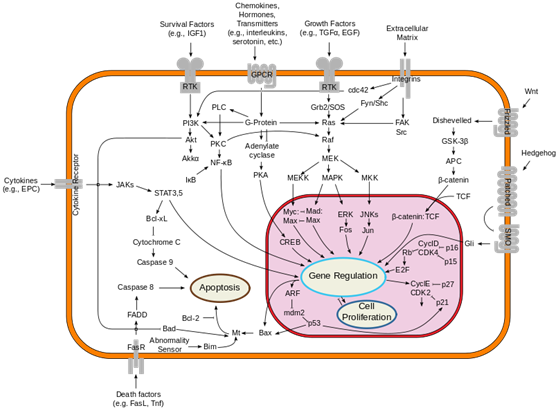Tumor protein p53, also known as p53, cellular tumor antigen p53, phosphoprotein p53, or tumor suppressor p53, is a protein that in humans is encoded by the TP53 gene. The p53 protein is crucial inmulticellular organisms, where it regulates the cell cycle and, thus, functions as a tumor suppressor, preventingcancer. As such, p53 has been described as “the guardian of the genome” because of its role in conserving stability by preventing genome mutation.Hence TP53 is classified as a tumor suppressor gene [1].
P53 is also known as cellular tumor antigen p53 (UniProt name), antigen NY-CO-13, phosphoprotein p53, transformation-related protein 53 (TRP53) and tumour suppressor p53.
 If the TP53 gene is damaged, tumor suppression is severely reduced. People who inherit only one functional copy of the TP53 gene will most likely develop tumors in early adulthood, a disorder known as Li-Fraumeni syndrome. The TP53 gene can also be damaged in cells by mutagens (chemicals, radiation, or viruses), increasing the likelihood that the cell will begin decontrolled division. More than 50 percent of human tumors contain amutation or deletion of the TP53 gene. Increasing the amount of p53, which may initially seem a good way to treat tumors or prevent them from spreading, is in actuality not a usable method of treatment, since it can cause premature aging. However, restoring endogenous p53 function holds a lot of promise. Research has been done to show that this restoration can lead to regression of certain cancer cells without damaging other cells in the process. The ways in which tumor regression occur depends chiefly on tumor type. With restoration of endogenous p53 function, lymphomas exhibit apoptosis and cell growth is lowered to normal levels. Thus, pharmacological reactivation of p53 presents itself as a viable cancer treatment option. Loss of p53 creates genomic instability that most often results in the aneuploidy phenotype [2].
If the TP53 gene is damaged, tumor suppression is severely reduced. People who inherit only one functional copy of the TP53 gene will most likely develop tumors in early adulthood, a disorder known as Li-Fraumeni syndrome. The TP53 gene can also be damaged in cells by mutagens (chemicals, radiation, or viruses), increasing the likelihood that the cell will begin decontrolled division. More than 50 percent of human tumors contain amutation or deletion of the TP53 gene. Increasing the amount of p53, which may initially seem a good way to treat tumors or prevent them from spreading, is in actuality not a usable method of treatment, since it can cause premature aging. However, restoring endogenous p53 function holds a lot of promise. Research has been done to show that this restoration can lead to regression of certain cancer cells without damaging other cells in the process. The ways in which tumor regression occur depends chiefly on tumor type. With restoration of endogenous p53 function, lymphomas exhibit apoptosis and cell growth is lowered to normal levels. Thus, pharmacological reactivation of p53 presents itself as a viable cancer treatment option. Loss of p53 creates genomic instability that most often results in the aneuploidy phenotype [2].
Study of P53 has always been the hot spot of the oncology, recently also have a very interesting article showed P53 have new signaling pathways. The ARF and p53 tumor suppressors are thought to act in a linear pathway to prevent cellular transformation in response to various oncogenic signals. Here, we show that loss of p53 leads to an increase in ARF protein levels, which function to limit the proliferation and tumorigenicity of p53-deficient cells by inhibiting an IFN-β-STAT1-ISG15 signaling axis. Human triple-negative breast cancer (TNBC) tumor samples with coinactivation of p53 and ARF exhibit high expression of both STAT1 and ISG15, and TNBC cell lines are sensitive to STAT1 depletion. We propose that loss of p53 function and subsequent ARF induction creates a selective pressure to inactivate ARF and propose that tumors harboring coinactivation of ARF and p53 would benefit from therapies targeted against STAT1 and ISG15 activation [3].
Kangbeibio has developed and continuously expands upon a comprehensive list of small molecule inhibitors, relevant to multiple channels and active sites critical to biological processes. Kangbeibio has many P53 signaling pathway inhibitors; if you want to research inflammatory response, Kangbeibio (www.kangbeibio.com) can help you.
References [1] Cho Y, Gorina S, Jeffrey PD, Pavletich NP (1994). “Crystal structure of a p53 tumor suppressor-DNA complex: understanding tumorigenic mutations”.Science 265 (5170): 346–55. [2] http://en.wikipedia.org/wiki/P53 [3] Forys JT, et al. ARF and p53 coordinate tumor suppression of an oncogenic IFN-β-STAT1-ISG15 signaling axis. Cell Rep. 2014 Apr 24;7(2):514-26.




